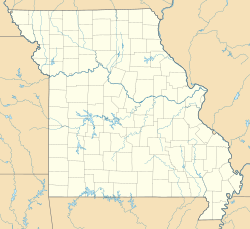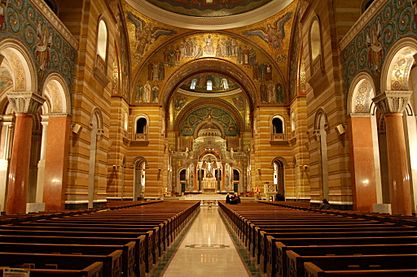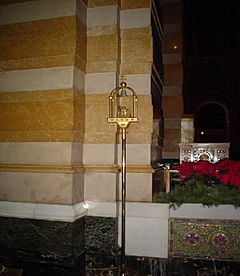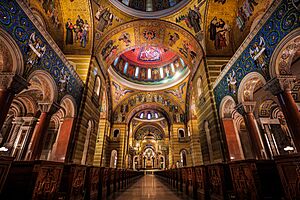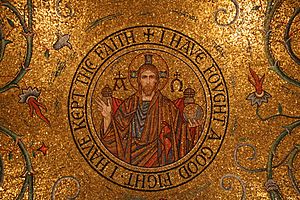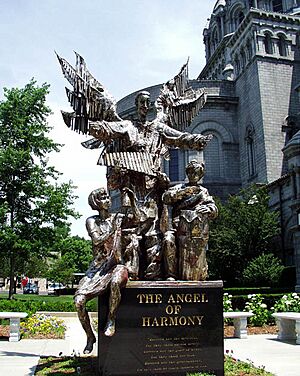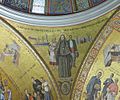Cathedral Basilica of Saint Louis (St. Louis) facts for kids
Quick facts for kids Cathedral Basilica of Saint Louis |
|
|---|---|
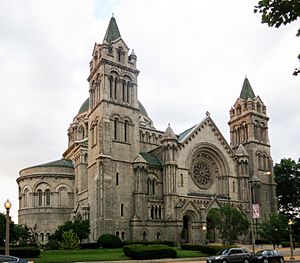 |
|
| 38°38′33″N 90°15′17″W / 38.64250°N 90.25472°W | |
| Location | 4431 Lindell Boulevard St. Louis, Missouri |
| Country | United States |
| Denomination | Roman Catholic Church |
| Website | www.cathedralstl.org |
| History | |
| Status | Cathedral, minor basilica |
| Founded | 1914 |
| Consecrated | June 29, 1926 |
| Architecture | |
| Architect(s) | Barnett, Haynes & Barnett |
| Style | Neo-Byzantine Romanesque Revival |
| Groundbreaking | 1907 |
| Completed | 1914 |
| Construction cost | $3,000,000 (1914 dollars) |
| Specifications | |
| Capacity | 2,500 (floor seating) 5,000 (including galleries) |
| Length | 365 feet (111 m) |
| Width | 204 feet (62 m) |
| Number of domes | Three |
| Dome height (outer) | 227 feet (69 m) |
| Dome height (inner) | 143 feet (44 m) |
| Dome diameter (inner) | 80 feet (24 m) |
| Number of spires | Two |
| Materials | Granite (exterior) Brick, marble, mosaic tiles (interior) |
| Administration | |
| Deanery | South City |
| Archdiocese | Archdiocese of St. Louis |
The Cathedral Basilica of Saint Louis is a beautiful Catholic church in St. Louis, Missouri. People also call it the Saint Louis Cathedral or the New Cathedral. It was finished in 1914 and is the main church for the Archdiocese of St. Louis. The current Archbishop, Mitchell T. Rozanski, leads services here.
The cathedral is named after Saint Louis, a French king. In 1997, Pope John Paul II gave it the special title of a basilica. This means it's a very important church. It replaced an older church, the Basilica of St. Louis, King of France, which was closer to the Mississippi River.
Work on the cathedral started on May 1, 1907. The first Mass was held on October 18, 1914, when the main building was ready. The church was officially dedicated on June 29, 1926. This cathedral is famous for its huge mosaic art, which is one of the biggest in the Western Hemisphere. It also has special burial places called crypts.
Contents
Building the Cathedral
Planning for this amazing cathedral began way back in the 1870s. Archbishop Peter Richard Kenrick started the idea, and Archbishop John Joseph Kain helped raise money for it. A group called the St. Louis Cathedral Building Association was formed in 1871 to help make it happen.
The real construction started when Archbishop John J. Glennon took charge. The design was created by the architecture firm Barnett, Haynes & Barnett, with Thomas P. Barnett leading the team. The first ground was broken on May 1, 1907. The building's cornerstone, a special first stone, was laid on October 18, 1908.
By 1914, enough of the building was finished for a dedication ceremony. However, the church wasn't fully consecrated until June 29, 1926. Even after that, the beautiful mosaics inside weren't completely finished until 1988!
The cathedral grounds also include a unique round building called the Chancery Building. It was designed around 1965 by architect Wenceslaus Sarmiento.
Amazing Mosaics
The installation of the stunning mosaics inside the cathedral began in 1912. These mosaics were finally completed in 1988. They are made from 41.5 million tiny pieces of glass, called tesserae. These pieces come in more than 7,000 different colors!
The mosaics cover a huge area of 83,000 square feet (7,700 m2). This makes it the largest collection of mosaics in the entire world.
Some of the mosaics in the side chapels and sanctuary walls were designed by Tiffany Studios. However, the main cathedral mosaics were designed by August Oetken. Many skilled artists worked on installing these mosaics. This included Hildreth Meiere, Ravenna Mosaic, Inc., and especially Paul and Arno Heuduck, a father and son team who worked on the mosaics for most of their lives. Emil Frei, Inc. of St. Louis also helped.
The entrance area, called the narthex, shows scenes from the life of King Louis IX of France. He is the person the city and church are named after. The back dome has mosaics showing important events from the archdiocese. The main dome, designed by Jan Henryk de Rosen, shows scenes from both the Old Testament and New Testament of the Bible.
Crypts and Museum
Below the main church, in the basement, there is a museum. This museum tells the story of the church's mosaics. It also displays other interesting artifacts found within the cathedral.
Also in the basement is a special chapel. This chapel is dedicated to the memory of past leaders of the Archdiocese. Important church leaders like Cardinals John J. Glennon, Joseph Ritter, and John Carberry, along with Archbishop John L. May, are buried in the cathedral's crypt.
The Angel of Harmony Sculpture
In 1999, a large sculpture called "The Angel of Harmony" was placed on the church lawn. It is 14 feet tall and made of welded stainless steel by artist Wiktor Szostalo. This sculpture was a gift from Adelaide Schlafly. She gave it in memory of her husband, Daniel Schlafly, who worked for fairness and peace among different groups of people.
The sculpture shows a winged angel with African-American features. Behind the angel are three children with Hispanic, Asian, and European features. They are playing music together, symbolizing peace. The base of the statue is made of granite. It has quotes from the New Testament, Pope John Paul II, and Martin Luther King Jr.. The sculpture teaches about harmony, peace, and fairness for all people.
Sadly, on September 17, 2024, the statue was damaged by someone. The person was later arrested.
The Grand Organ
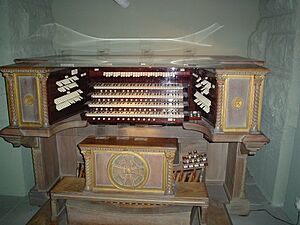
The cathedral has a very large and impressive organ. It was first built in 1915 by Geo. Kilgen and Son, Inc. This original organ had two keyboards, called consoles. One was in the gallery with the organ pipes, and the other was behind the main altar.
In 1946, Kilgen installed a new organ. This 1946 organ had 77 sets of pipes, called ranks. Fourteen of these ranks came from the older organ. In 1948, an Echo Organ from Carnegie Hall in New York City was added to the cathedral. The organ was updated again in 1984 by the M. P. Moller organ company.
In 1997, the Wicks Organ Company from nearby Highland, Illinois, started a big restoration project. They added more pipes, bringing the organ to 96 ranks. They also added some digital sounds. A new four-manual console replaced the old one behind the altar, and the gallery console was updated. Wicks also modernized the organ's electronic parts.
In the winter of 2002, the gallery organ was made even bigger. A new section of pipes was added in the dome area. The final step was replacing the original gallery console with a five-manual console in 2010. This new console, named the Ragen Organ Console, came from St. Bartholomew's Church in New York City and was fully restored. Now, every part of the organ can be controlled from either the gallery console or the movable console near the altar.
The original Kilgen console is now in the basement museum. Visitors can see it there. The gallery organ is often part of cultural tours in St. Louis.
Gallery
-
Southeast Pendentive depicting St. Isaac Jogues
-
Southwest Pendentive depicting St. Frances Xavier Cabrini
-
Northeast Pendentive depicting St. Rose Philippine Duchesne
See also
 In Spanish: Catedral basílica de San Luis (San Luis) para niños
In Spanish: Catedral basílica de San Luis (San Luis) para niños
- List of churches in the Roman Catholic Archdiocese of St. Louis
- List of Catholic cathedrals in the United States
- List of cathedrals in the United States
- List of tallest domes
- Mary A. Reardon


